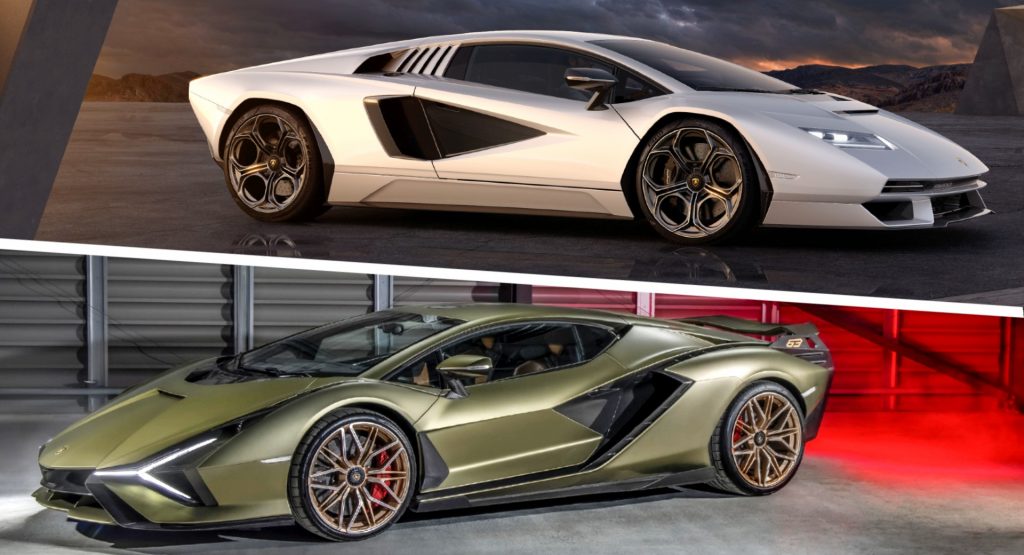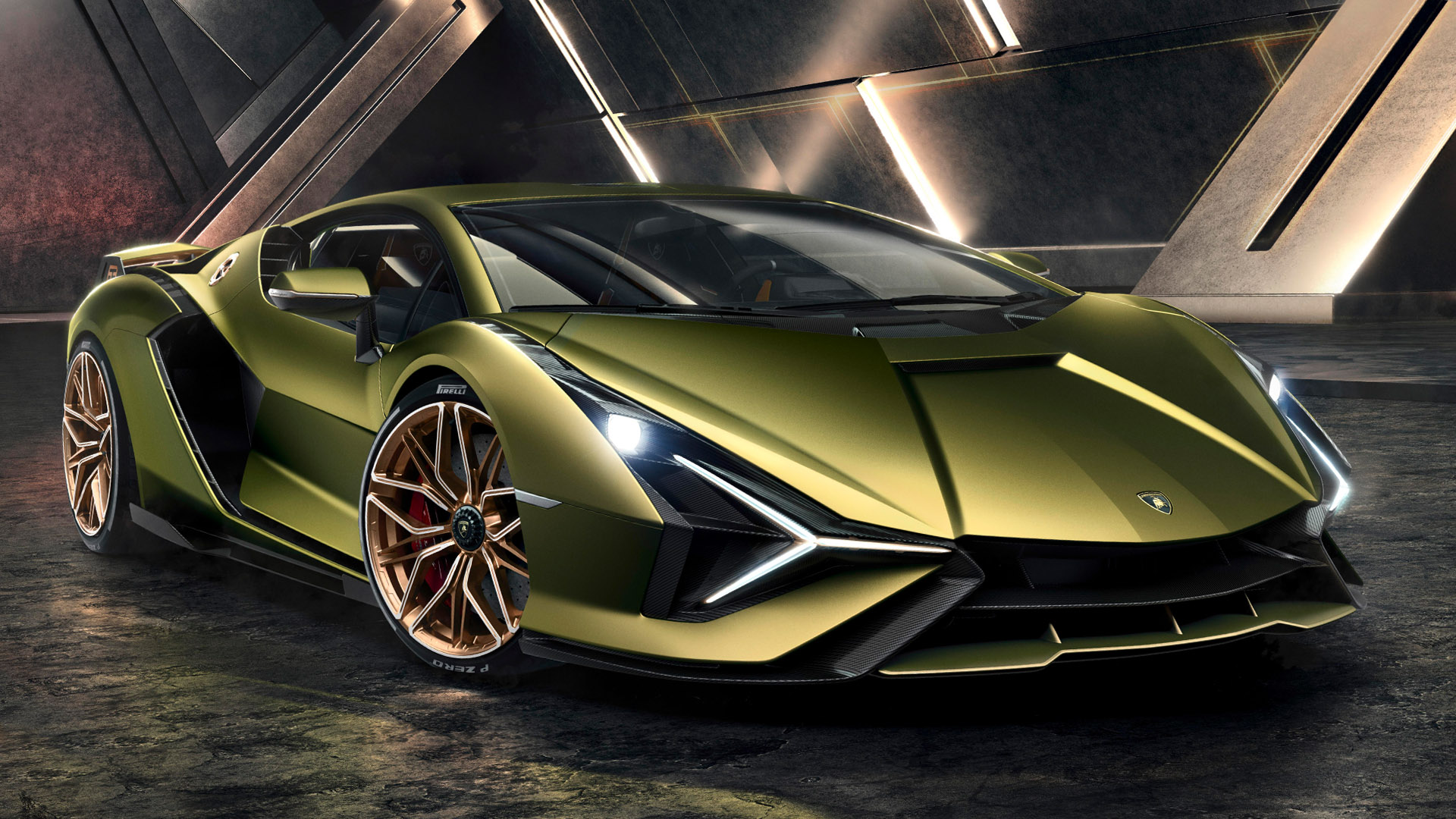The recently unveiled Countach LPI 800-4 is sharing its underpinnings with the Sián FKP 37 including the carbon-fiber monocoque, the mild-hybrid V12 (in a slightly less powerful guise), and the supercapacitor. However, despite featuring a completely redesigned bodywork made of carbon fiber, the modern version of the legendary Countach has a few more similarities with the Sián that can’t be unseen. This is why we decided to make a side-to-side visual comparison and carefully examine the design of the two limited edition specials from Sant’Agata.
Starting with the front end, the difference in the design approach is evident from the first glimpse. The Countach has a flatter nose with simple lines and rectangular intakes which has nothing in common with the ultra-aggressive elements on the Sián. The only common design feature is the negative angle of the lines towards the bonnet intake (they are actually the shut lines on the Countach), which is a design element found, in different variations, in almost every Lamborghini model since the 1974 Countach LP400.
What is definitely common in both cars is the Aventador-derived front windshield, the A-pillars, and roof structure – at least up to the B-pillar. This is more evident from a 3/4 or a side view where you can also see the identical side windows and mirror caps.
See Also: Lamborghini Sián FKP 37 Visits Bologna To Celebrate The Latest World Heritage Site
As expected, from the profile, the proportions look quite similar. At the end of the day, this is something that designers can’t easily alter when they were working around the same monocoque, engine layout, greenhouse, wheelbase, wheelsize (20-inches at the front and 21-inches at the rear), and tracks – especially considering they needed to maintain the characteristic wedge silhouette.
Besides the side windows and roofline looking similar to the Aventador‘s, the Countach has some retro-inspired features that are not shared with the Sián. These include the hexagonal wheel-arches front and rear, the unique rims, and the different shapes of the side intakes. If you are wondering why the NACA-style air-duct is so much larger compared to the original Countach, just look at the side intakes of the Sián and the Aventador to get an idea of how much cooling is needed for the modern V12. The Sián also gets more aggressive side sills matching its front splitter.
And now we move to the rear end which is the most similar-looking angle for the two models. For a start, both of them share the same hexagonal three-unit LED taillights. This is a weird decision considering the exclusive nature of the Countach revival that could justify the development cost for unique lighting units.
Another design feature that looks quite similar in both cases is the “periscope” design of the roof, although the engine cover and the surrounding area are redesigned in the Countach. The Sián also has the signature side fins complimenting the active rear spoiler. Although the latter is probably a unique part given the surface treatment of the tail, it is likely that the Countach has a similar active wing which contributes to a clean design.
Below the headlights, each car gets its own bumper design, with the Countach adopting a more sensible approach for the intakes and the diffuser which is integrated more nicely in the design. The same can be said about the four round tailpipes of the Countach instead of the hexagonal dual pipes of the Sián. Having said that, both supercars get similar short-cut treatment for the bumper revealing a large portion of the wide rear tires.
Inside, both cars have many Aventador-derived components like the steering wheel and the digital instrument cluster, but they feature a unique center console and tunnel with a larger 8.4-inch infotainment touchscreen and a more modern design for the controls.
Differences between the Countach and the Sian cabin are limited to the seat design (the former shares the seats with the Aventador), the unique climate vents, and the shape of the leather trim on the central tunnel, doors, and roofliner. The Countach also has the “Stile” button that initiates a presentation of the car’s design philosophy.
And after we covered the design of both the exterior and the interior, let’s take a quick look into the shared powertrain. It consists of a 6.5-liter naturally aspirated V12, a 48-Volt e-motor, an automatic gearbox and a supercapacitor, but there’s a slight difference in terms of combined output.
More specifically, the Countach LPI 800-4 produces a combined 803 hp (599 kW / 814 PS) while the Sián has 808 hp (603 kW / 819 PS). This small difference in favor of the Sián has to do with the calibration of the naturally aspirated V12 engine and not with the identical 34 hp (25 kW / 34 PS) electric motor. In the Countach, the ICE motor produces 769 hp (574 kW / 780 PS) versus the Sián’s 774 HP (577 kW / 785 PS). Despite that, performance is identical, with 0-100 km/h (0-62 mph) acceleration in 2.8 seconds and 0-200 km/h (0-124 mph) in 8.6 seconds. The top speed is 355 km/h (221 mph) for the Countach and over 350 km/h (217 mph) for the Sián.
So this is our look at two very special Aventador-based Lamborghinis. Both are produced in limited numbers, with the Sián FKP 37 being more exclusive, with 63 units of the Coupe and 19 units of the Roadster versus the 112 units for the Countach LPI 800-4, which is only available as a coupe.
We don’t have pricing for the Countach LPI 800-4 but we expect it to cost less than the Sián FKP 37 which starts from $3,700,000. If you could afford them, which one of the two electrified bulls would you like to have in your garage?
















